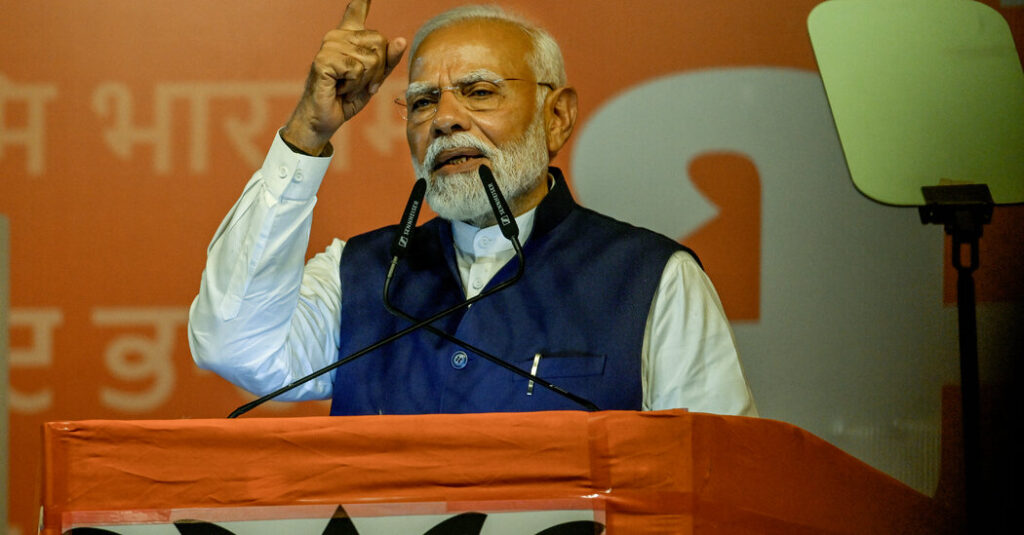Modi’s first decade as India’s prime minister has been full of surprises. None, however, looked like what happened on Tuesday morning, when he won a second term but lost the party’s majority in parliament.
With this defeat, Modi’s invincibility seemed to be fading for the first time since taking office in 2014.
The election results were particularly shocking because exit polls released days before the final tally showed Modi’s Bharatiya Janata Party would win in a landslide after nearly seven weeks of tense voting across the country. Two wins.
Instead, the BJP won only 240 seats, far short of the 272 needed to form a government. The opposition alliance led by the Indian National Congress won 235 seats.
Modi will remain in the lead as his BJP allies won 52 seats. But his charisma has waned and his leadership has fundamentally changed.
Modi’s invincibility was punctured.
Modi came to power in 2014 promising economic progress, an end to corruption and a push to make Hinduism central to India’s identity. Through it all, he presented himself as a unique and powerful leader, capable of rallying his followers to serve their country.
This is in stark contrast to the previous government. Before Mr Modi was first elected, India had experienced 25 years of coalition rule. Prime ministers from the Congress, the Bharatiya Janata Party and smaller third parties take turns running India through committees. Mr Modi broke with that tradition and led a new one-party system dominated by the Bharatiya Janata Party
As a leader, Modi has little interest in sharing power. In 2016, when he announced that most of India’s currency notes would be invalidated, even his finance minister had no prior knowledge of the decision. When he decided to impose de facto martial law on India’s only Muslim-majority state of Jammu and Kashmir, he presented the plan to parliament as a done deal without seeking approval.
But those days are over.
The two largest parties that have emerged as the BJP’s new alliance partners are led by N. Chandrababu Naidu and Nitish Kumar, senior legislators known as technocratic moderates. Both are likely to demand greater powers in parliament. In fact, both are seen as possible prime ministerial candidates if there is another alliance led by neither the BJP nor the Congress.
India’s political landscape was reshaped overnight.
When the first national electoral maps showing gains and losses in parliamentary seats were released on Tuesday, they revealed a striking new pattern.
Maps show Modi’s party losing large swaths of territory in Hindi-speaking states, which are seen as strongholds of the Bharatiya Janata Party.
Meanwhile, the BJP has made gains in areas that have resisted Modi in the past. He lost dozens of seats in Uttar Pradesh but gained large numbers in the eastern state of Odisha and the southern state of Telangana.
Now, the only part of the country that appears to be unified by one party is the “tribal belt” across the central states. The BJP’s Hindu-first politics and welfare subtly target its relatively poor communities.
Wall Street in India has been full of twists and turns.
Investors in India’s Mumbai stock market responded enthusiastically to the early exit polls. Their buying spree continued on Monday, pushing up prices of so-called Modi stocks that are tied to the prime minister’s spending priorities or thought to benefit from his fiscal policies.
When the actual votes are tallied, these stocks will plummet. Shares of Adani Group’s flagship stock fell about 19% in the day’s trading. The blue-chip index fell about 6%, nearly erasing gains in the first five months of the year.
Modi remains popular with India’s business tycoons, but investors need to find out which companies will benefit from the new government.
Chris Wood, global head of equity strategy at investment bank Jefferies, warned last year that he “expected a 25% correction in Indian equities, if not more” if Modi lost the election. Historically, Indian companies have performed equally well during coalition governments. Therefore, Wood said that even if Modi does not take power, he expects the stock market to “rebound significantly” based on the strength of the country’s overall economy.
Alliance politics are back – expect a game of musical chairs.
This new era in Parliament is sure to begin with rounds of political revenge. Politicians who fail to give their bosses a seat at the table will be kicked out. Smaller parties may demand cabinet posts, meaning replacement of BJP members
The policy needs to be revised. Will India turn to export manufacturing, aiming to replace China as the world’s factory? Will it act to protect local industries that fear foreign competition?
Milan Vaishnav, a senior fellow at the Carnegie Endowment for International Peace, warned that India cannot fully return to pre-Modi alliance politics. His new partners are likely to make demands that match Modi’s authoritarian style in New Delhi.
Vaishnav said the kind of national leader he now needs as a coalition partner is “as authoritarian as the national government”. For example, they could call on federal police agencies to arrest opponents, as Modi has done.
India’s elections are the largest in the history of democracy, with more than 600 million voters voting in six phases. This time, there are no complaints about electronic voting machines or concerns about India becoming a dictatorship under Modi.
Modi delivered a difficult speech at the Bharatiya Janata Party headquarters on Tuesday night, calling the election a “celebration of democracy”.

